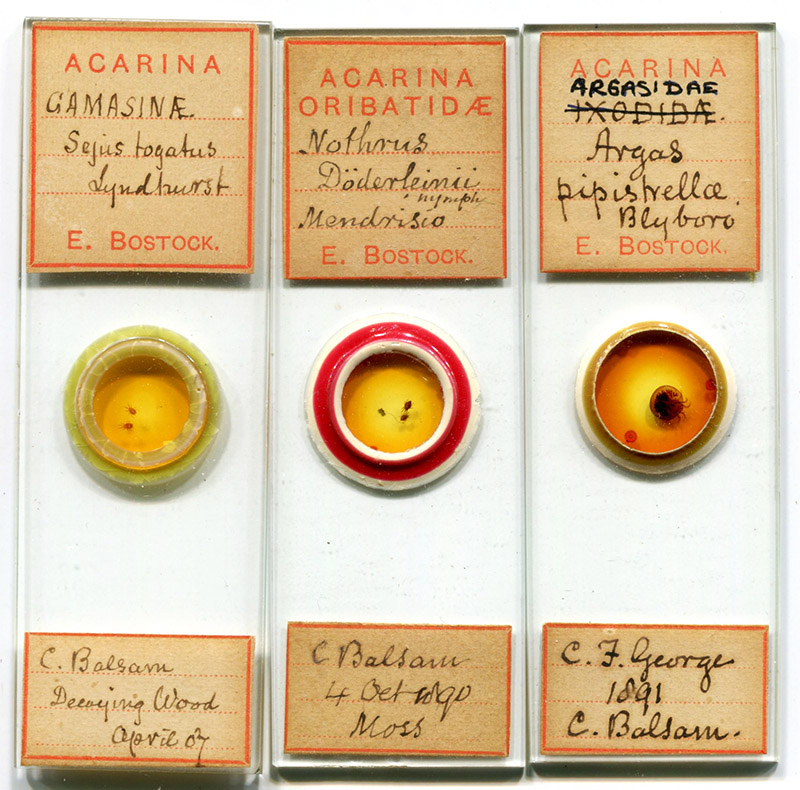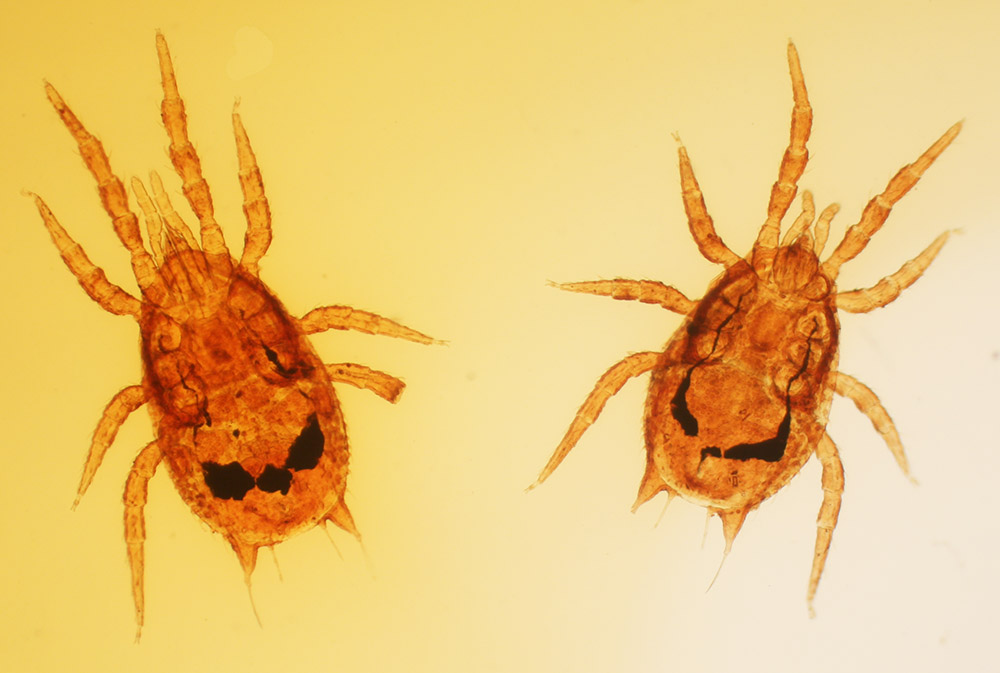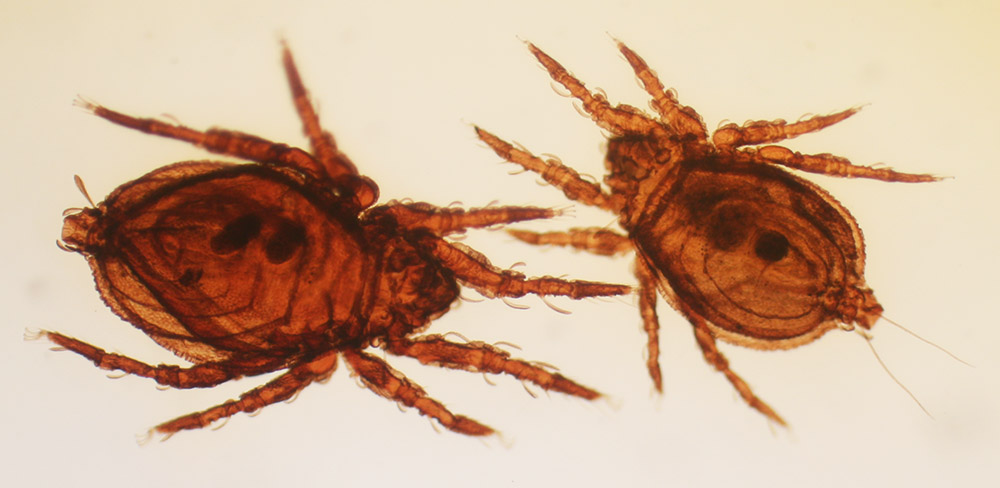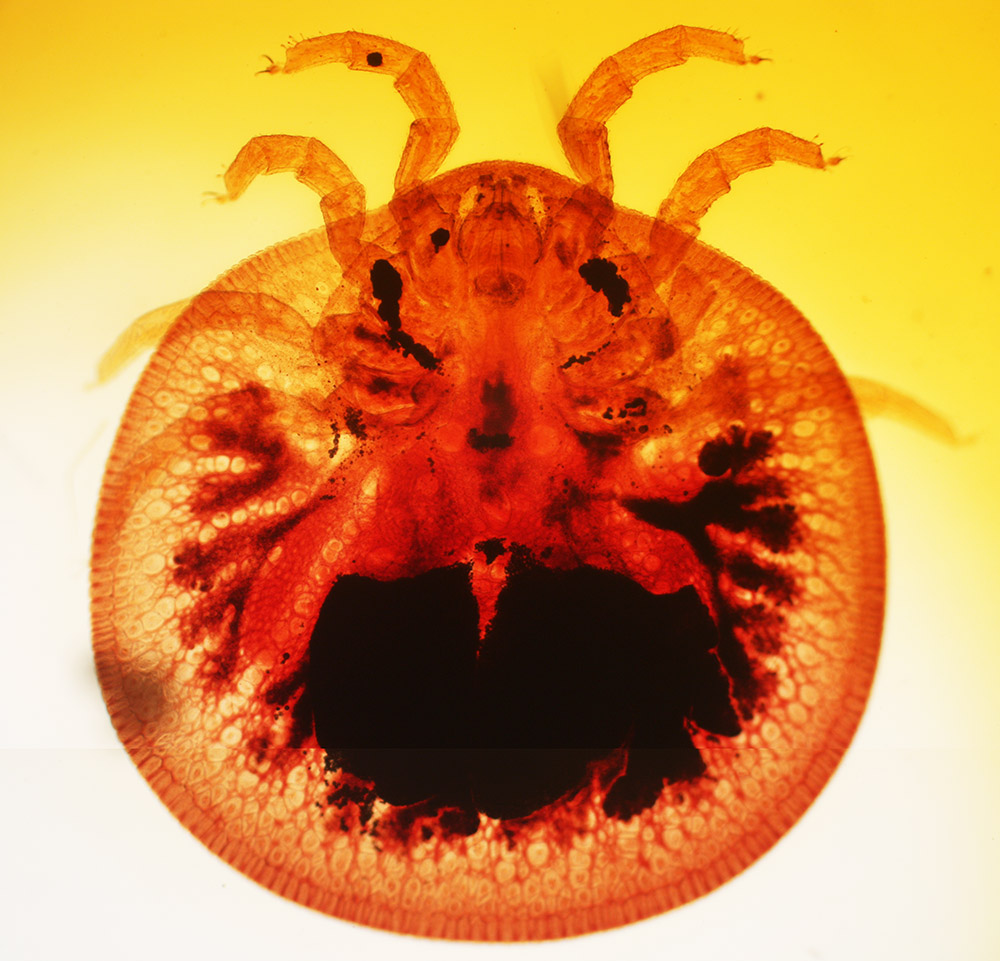Edwin Bostock, 1838 - 1901
by Brian Stevenson
last updated June, 2021
Edwin Bostock was a wealthy industrialist, and an amateur naturalist with a particular interest in oribatid mites (free-living mites that eat detritus and contribute to the breakdown of organic matter in soil). He reportedly assembled a large collection of specimens from throughout the British Isles, as well as continental Europe and New Zealand. He also supplied a substantial number of mite specimens to noted acarologists such as Albert D. Michael (1836-1927), and often accompanied Michael on his collecting expeditions. On his death, Bostock left his collection to Michael - the slides shown below were acquired along with several by Michael, and may well have been part of Bostock's bequest.

Figure 1.
Three microscope slides by Edwin Bostock, dated 1887, 1890, and 1891. All are of acari of various sorts. Bostock noted on the rightmost slide that he acquired the specimen from Charles Frederick George, (1833-1923), also a notable microscopist and acarologist.

Figure 2.
Two specimens of Sejus togatus, prepared by Edwin Bostock in April, 1887 (see Figure 1). This species is a predatory mite (gamasinae). Photographed with a 3.5x objective lens and a C-mounted digital SLR camera on a Leitz Ortholux II microscope.

Figure 3.
Two specimens of Nothrus doederleinii, an oribatid mite, prepared on October 4, 1890. Bostock noted that he collected these specimens in moss. Photographed with a 3.5x objective lens and a C-mounted digital SLR camera on a Leitz Ortholux II microscope.

Figure 4.
An argasid tick ("soft" tick), described as Argas pipistrellae (now Carios vespertilionis). Ticks are parasitic acari, divided into two major families: argasidae (the soft ticks) and Ixodidae (the hard ticks, the type that most of us are familiar with). Bostock originally labeled this specimen as an "Ixodidae", which was corrected at a later date. Photographed with a 3.5x objective lens and a C-mounted digital SLR camera on a Leitz Ortholux II microscope.

Figure 5.
Edwin Bostock with some of his family. Judging from son Colin's age, it was probably taken during the late 1890s. Adapted for nonprofit, educational purposes from http://www.bostock.net/tree/bostgen/names/duff/pictures/edwingroup.jpg
Edwin Bostock's grandfather, Thomas Bostock, established a shoe-making factory in Stafford, Staffordshire in 1814, which Thomas' sons expanded into three successful factories. Thus, our microscopist was born into wealth on February 28, 1838. He later took on management of the facility in Stone, Staffordshire.
Edwin married Louisa Ellen Dillon on October 19, 1864. They had four children over the next five years, although one died when just over a year old. A month after the birth of the fourth child, in 1869, Louisa also died. On May 31, 1874, Edwin married a second time, to Jane Thompson, with whom he had an additional five children (see Figure 5).
It is not clear what drove Bostock's interest in microscopy and the natural sciences, but he joined the Royal Microscopical Society in 1880 and the Linnean Society in 1883. Both of those societies met in London, some 150 miles / 240 km from his home in Stone, Staffordshire. He probably did not attend many meetings, but instead would have enjoyed society publications and the exchange of letters with other members. Among those, evidently, were A.D. Michael and C.F. George (see above). Both were amateur microscopists and acarologists (those who study mites and ticks), who had jointly written "A contribution to the knowledge of British Oribatidae" for the Journal of the Royal Microscopical Society in 1879. Michael and George later went on collecting trips with Bostock, so the combination of friendship and a broad, yet understudied, field may have led Bostock to also investigate oribatids and other mites. As a side note, the oribatid mites are still a poorly understood group of animals.
Bostock does not appear to have written much on his studies of mites – I found only one record, of a talk to his North Staffordshire Field Club in 1887. However, A.D. Michael's numerous publications frequently thank Bostock for specimens, such as his "Observations on the Anatomy of the Oribatidae" that acknowledged, "I wish to express my thanks to … Mr. E. Bostock, of Stone, and Mr. C.F. George, of Kirton Lindsey, for supplies of living specimens which enabled me to continue the research in London". Michaels' 1888 British Oribatidae, Vol. 2, thanked Bostock at least 13 times, with multiple acknowledgements that Bostock had discovered many of the described species. Bostock and Michael traveled together with some frequency – Michael's 1891 "On the association of gamasids with ants" began with, "This paper records some observations made during the present year (1891), chiefly near Ajaccio in Corsica and near Innsbruck in Tyrol. In the former locality the Ants' nests examined were at a level of not more than 500 feet above the sea; those in the Tyrol were at levels varying from about 3000 to over 4000 feet above the sea. In both places I had the great advantage of the company of Mr. E. Bostock of Stone".
Edwin Bostock travelled to New Zealand in about 1889. Upon his return, he offered to exchange his photographs for optical equipment or collections (Figure 6). While in that country, Bostock made a substantial collection of mites. These were later described by A.D. Michael, "My friend the late Edwin Bostock, of Tixal near Stafford, at his death, left a considerable collection of Acari, chiefly Oribatidae, both British and foreign. The British collection has already been fully dealt with, but there has not hitherto been any attempt made to describe or illustrate the foreign species. The most important portion of these preparations consists of specimens from New Zealand; they are wholly Oribatidae with the exception of two specimens of Gamasidae, both most remarkable creatures. Failing health and other causes prevented Mr. Bostock from attempting to publish any account of the novelties contained in this collection during his life, but he bequeathed the collection to me. Mr. Bostock was an admirable collector and preserver of Acari, and I have often had occasion to thank him for assistance in my former work; he also had a remarkable power of interesting others in his pursuits, and obtaining their help at times when and in places where he could not personally carry on his collecting. The present gathering was made partly by Mr. Bostock himself during visits to New Zealand, and partly by Mr. J. W. Baker and other residents in that country, whose assistance in collecting Mr. Bostock secured. The collection is decidedly the finest of extra-European Oribatidae which I have yet seen".
In addition to personally collecting specimens, Bostock sought out exchanges throughout the world. For example, an 1889 offer that he published in the American Monthly Microscopical Journal (Figure 7).
Edwin Bostock's life was cut short by a cancer, dying on November 23, 1901.

Figure 6.
An 1890 exchange offer by Edwin Bostock, from "Hardwicke's Science-Gossip".

Figure 7.
An 1889 exchange offer, from "The American Monthly Microscopical Journal".

Figure 8.
Picture postcards of the Bostock shoe factory, Stafford. Adapted for nonprofit, educational purposes from internet auction sites.
Resources
The American Monthly Microscopical Journal (1889) Exchange offer from Edwin Bostock, Vol. 10, page 144
Arch Music Man (2013) Shawms and Upmeads - two mini Midland architectural masterpieces
and The Bostock family of Stafford - 1815-2015, http://archmusicman.blogspot.com/2013/09/shawms-and-upmeads-two-mini-midland.html, accessed June, 2021
England census and other records, accessed through ancestry.com
Hardwicke's Science-Gossip (1890) Exchange offer from E. Bostock, Vol. 26, pages 239-240
The Journal of the Linnean Society: Botany (1890) "Fellows: … 1883. Dec. 6. Bostock, Edwin, Esq. The Radfords, Stone, Staffordshire", Vol. 25, page 8
Journal of the Royal Microscopical Society (1889) "Fellows: … 1880 Bostock, Edwin, F.L.S., The Badfords, Stone, Staffordshire"
Michael, A.D, and C.F. George (1879) A contribution to the knowledge of British Oribatidae, Journal of the Royal Microscopical Society, pages 32-43 and 177-201
Michael, A.D. (1883) Observations on the Anatomy of the Oribatidae, Journal of the Royal Microscopical Society, pages 1-25
Michael, A.D. (1888) British Orbatidae, Ray Society, London
Michael, A.D. (1891) On the association of gamasids with ants, Proceedings of the General Meetings for Scientific Business of the Zoological Society of London, pages 638-653
Michael, A.D. (1892) On the Variations in the Internal Anatomy of the Gamasinæ, especially in that of the Genital Organs, and on their Mode of Coition, Transactions of the Linnean Society of London: Zoology, pages 281-285
Michael, A.D. (1907) Unrecorded Acari from New Zealand, Zoological Journal of the Linnean Society, Vol. 30, pages 134-149
The Naturalists' Directory (1896) "Bostock, Edwin, F.L.S., F.R.M.S., Tixall Lodge, Stafford. Mic., Acarina, esp. Oribatidae. C. Ex.", page 281, Cassino, Boston
Probate of the will of Edwin Bostock (1902) "Bostock Edwin of Tixall-lodge Staffordshire died 23 November 1901 Probate London 3 February to Henry Bostock, Edwin Dillon Bostock and Harry Bostock shoe-manufacturers Effects £33944 19s 2d", accessed through ancestry.com







